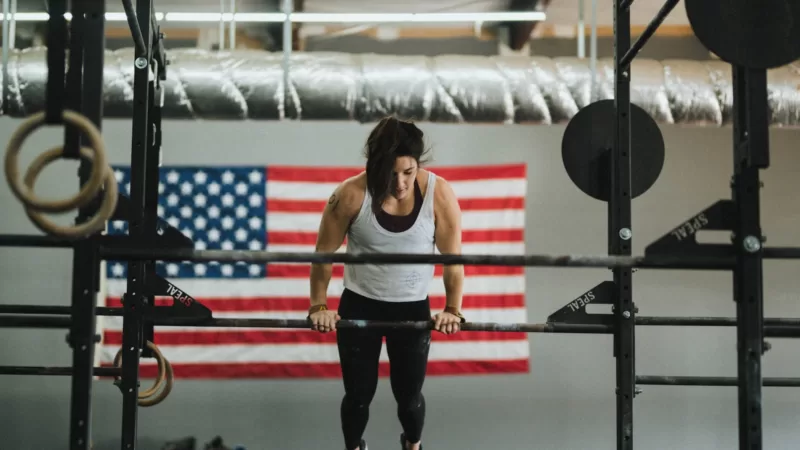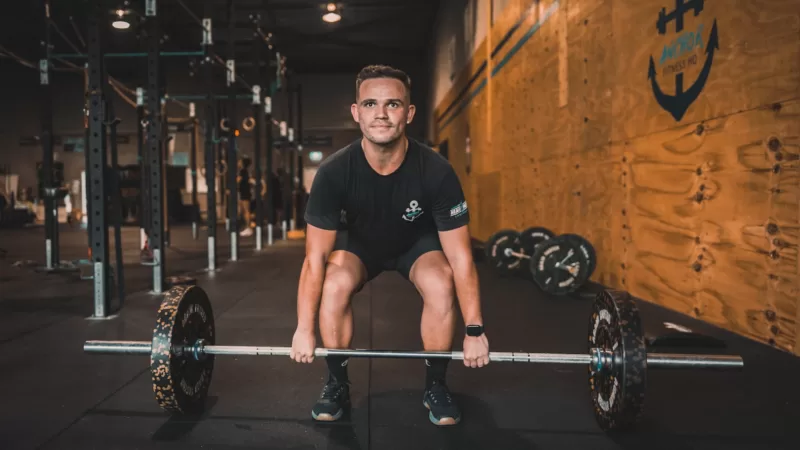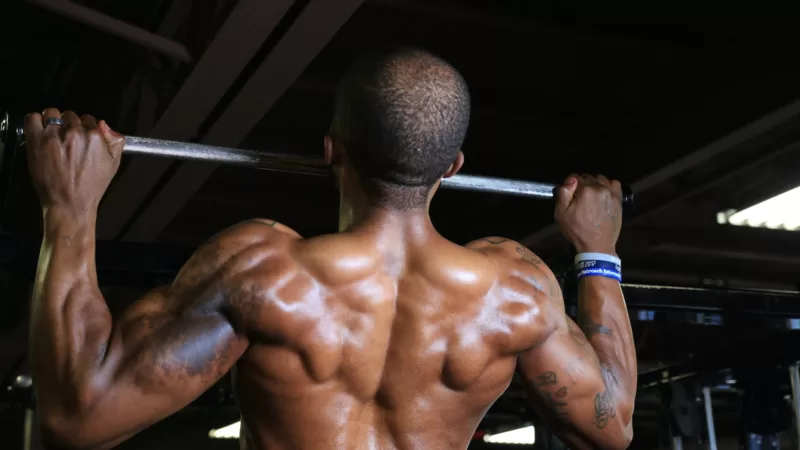Hang Clean vs Power Clean: Unveiling the Differences & Benefits
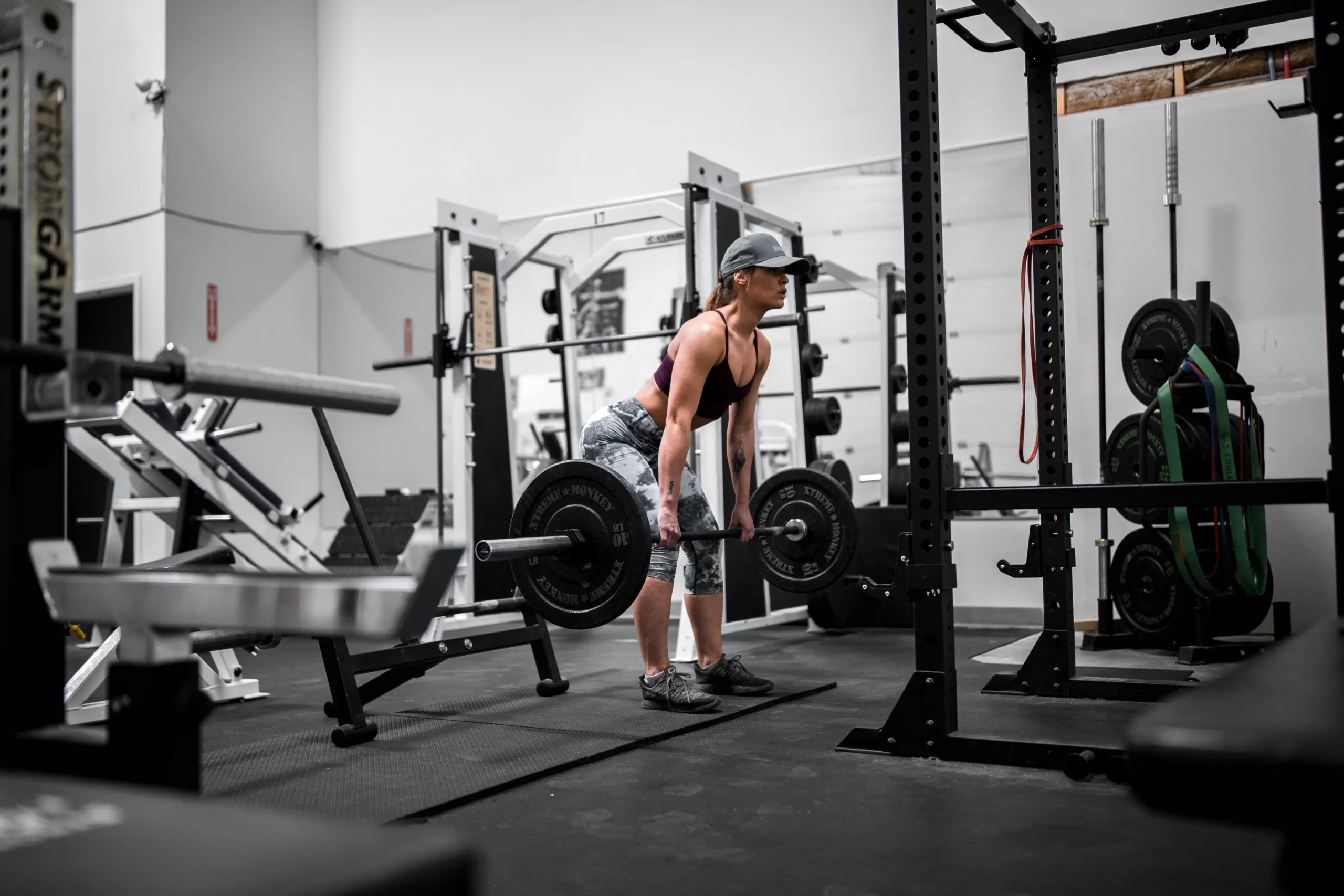
Are you ready to unleash your inner strength and power? If you’re a fitness enthusiast or an athlete looking to take your force development training to the next level, then hang clean and power clean exercises are two variations of Olympic weightlifting that deserve your attention. These explosive movements engage your entire body, helping you build strength, speed, and agility like never before. Whether you’re an exerciser or a lifter, these exercises will help you reach new levels of performance.
Hang clean and power clean have become popular choices among athletes and weightlifters due to their ability to enhance athletic performance through strength training. But what sets these weightlifting movements apart? The key differences lie in the starting positions and techniques used for each exercise, specifically in the parallel squat position and the use of explosive power. These exercises are highly beneficial for athletes looking to improve their overall strength and power.
In the hang clean, a popular weightlifting movement used in strength training by Olympic weightlifters, you start with the barbell at mid-thigh level. In contrast, the power clean begins from the floor. This variance in starting position affects how much force is generated throughout the movement and can impact which muscles are targeted more intensely during each exercise.
There’s no one-size-fits-all answer when it comes to weightlifting movements. It depends on the goals and preferences of Olympic weightlifters and exercisers. Hang cleans may be advantageous for developing explosive hip extension and improving coordination, while power cleans can help build lower body strength and increase overall power output, including vertical jump.
Get ready to discover new heights of athleticism as we dissect the hang clean vs power clean showdown! These weightlifting movements are essential for improving vertical jump and overall strength training for athletes.
Understanding the Difficulty and Complexity of Power Clean:
The Coordination, Timing, and Power Required
Power clean is a strength training exercise that demands a unique combination of coordination, timing, and power for the lifter. It involves explosively pulling a barbell from the floor to shoulder height while transitioning into a deep squat position. This explosive movement requires precise coordination between various muscle groups to generate maximum power for the lifter’s vertical jump. Each repetition of the power clean builds strength and power in the lifter’s muscles.
To execute a successful power clean, athletes must synchronize their lower body drive with an explosive upper body pull. This timing is crucial for maximizing vertical jump performance and preventing injury. Any mistiming can diminish power output or lead to harm. Paying attention to the details of each repetition is key.
The Rapid Transition from Pulling to Catching
One of the defining aspects of the power clean for an athlete is its rapid transition from pulling to catching the barbell, which requires exceptional speed and agility. After generating power through an explosive triple extension (ankle, knee, hip), lifters quickly transition by pulling themselves under the barbell into a front squat position. This seamless switch demands repetition and weight.
The ability to smoothly transition from a hang power clean to a squat clean requires not only physical strength but also mental focus. Lifter athletes must be able to react swiftly and make split-second decisions on when and how to catch the barbell securely. It’s like performing an intricate dance move that combines strength, grace, and precision, repetition.
Simultaneous Multiple Joint Movements
Unlike some other weightlifting exercises that primarily target specific muscle groups or joints, power cleans incorporate multiple joint movements simultaneously. During this exercise, athletes engage in a coordinated effort involving repetition of the step of engaging their ankles, knees, hips, shoulders, elbows, and wrists.
The involvement of multiple joints in the repetition of clean exercises, such as the squat clean and hang power clean, adds complexity to the movement pattern. Each joint must contribute harmoniously for optimal performance. Proper technique is paramount for maintaining alignment throughout these various joint actions. Even a minor deviation in form can disrupt efficiency and compromise safety during heavy lifts.
Demanding Proper Technique for Optimal Performance
To master the power clean, athletes must devote time and effort to learning and perfecting the technique. Repetition of the proper form is essential not only for maximizing performance but also for minimizing the risk of injury. The intricacies of this derivative exercise require attention to detail and a commitment to continuous refinement.
Athletes should focus on maintaining a strong core during the hang power clean, squat clean, and clean exercise. Utilizing proper grip placement is crucial for a successful repetition. Initiating explosive triple extension is key to generating power. Smoothly transitioning into the catch position ensures proper technique. Exhibiting control throughout the movement is essential for preventing setbacks caused by poor technique.
Challenging Both Physical Strength and Mental Focus
The power clean is an exercise that challenges both physical strength and mental focus. It demands a high level of physical strength as it engages major muscle groups such as the quadriceps, glutes, hamstrings, back muscles, shoulders, and arms. The explosive nature of the lift requires athletes to generate significant force against resistance.
Moreover, mental focus plays a crucial role in executing a successful power clean. Athletes must concentrate on coordinating their movements precisely while maintaining awareness of their body positioning throughout each phase of the lift. Maintaining mental clarity amidst intense physical exertion can be just as demanding as the physical aspect itself.
Exploring the Differences: Hang Clean vs Power Clean
Hang Clean: Starting with Explosive Hip Extension
The hang clean is an exercise variation that focuses on explosive hip extension, essential for generating power and speed in movements like jumping or sprinting. This exercise is particularly beneficial for athletes as it starts from a static position with the barbell above the knees.
When performing the hang clean, an athlete begins by gripping the barbell with an overhand grip, hands slightly wider than shoulder-width apart. With their feet hip-width apart, they hinge at the hips and lower into a partial squat position. The barbell should be resting just above the athlete’s knees.
To initiate the hang power clean exercise, the athlete explosively extends their hips, driving them forward while simultaneously shrugging their shoulders and pulling themselves under the bar. As they catch the bar in a front rack position—elbows high and chest up—they quickly drop into a full squat before standing back up to complete one repetition of the clean exercise.
The hang clean’s starting position allows for greater emphasis on explosive hip extension, making it an excellent exercise for developing power and speed in athletic movements that require quick bursts of energy. This exercise is particularly beneficial for athletes looking to enhance their performance.
Power Clean: Greater Mobility and Flexibility Required
In contrast to the hang clean, the power clean begins from the floor with a deadlift motion. This means that you start with the barbell resting on the ground and perform a traditional deadlift to bring it up to your thighs before executing the rest of the movement. This exercise is particularly beneficial for athletes looking to improve their explosive power and overall strength.
Starting from this lower position in the squat clean requires greater mobility and flexibility for the athlete. Sufficient ankle dorsiflexion, hip mobility, and hamstring flexibility are necessary to maintain proper form and prevent injury during each rep.
Once you’ve lifted the barbell off the floor during a power clean, as an athlete, you continue by explosively extending your hips, shrugging your shoulders, and pulling yourself under the bar. The difference from the hang clean is that you start from a full deadlift position, which demands more range of motion and overall flexibility for athletes.
The power clean’s starting position from the floor challenges your mobility and flexibility while still developing explosive power. It can be a valuable exercise for athletes who need to improve their ability to generate force from a lower starting point, such as weightlifters or football linemen.
Unique Training Benefits of Each Variation
Both the hang clean and power clean offer unique training benefits for athletes that cater to different goals and requirements. Understanding these differences allows you, as an athlete, to choose the variation that aligns best with your specific needs.
The hang clean places greater emphasis on explosive hip extension, making it an excellent choice for athletes looking to enhance their jumping ability or sprinting speed. By starting in a static position above the knees, you can focus on generating maximum power through rapid hip extension.
On the other hand, the power clean is a great exercise for athletes who want to improve their overall strength and explosiveness while also developing functional range of motion. It requires greater mobility and flexibility due to its starting position from the floor.
It’s important to note that both the squat clean and clean variations work multiple muscle groups simultaneously, including the hips, glutes, quads, hamstrings, shoulders, and core. They both contribute to improved coordination and body control.
Muscles Worked: A Comprehensive Analysis of Hang Clean:
Quadriceps, Hamstrings, Glutes, and Calves
The hang clean is a compound exercise that targets major muscle groups in the lower body. One of the primary muscles worked during this movement is the quadriceps, which are located at the front of your thighs. These muscles play a crucial role in extending your knees and generating power during explosive movements like the hang clean.
In addition to the quadriceps, the hamstrings also come into action during the hang clean. Located at the back of your thighs, these muscles work in conjunction with the quadriceps to provide stability and control throughout the exercise. They help you maintain proper form and prevent any imbalance or excessive strain on your knees.
Furthermore, engaging your glutes is an essential aspect of performing a successful hang clean. The gluteal muscles are responsible for hip extension, which means they contribute significantly to generating power and explosiveness during this movement. By activating your glutes, you can maximize force production and enhance overall performance.
Lastly, let’s not forget about our calves! While they may seem relatively small compared to other muscle groups involved in the hang clean, they still play a vital role in providing stability and balance throughout the exercise. Your calf muscles work together with other leg muscles to ensure proper alignment and prevent any potential injuries.
Deltoids, Trapezius, Biceps, and Forearms
While primarily known as a lower body exercise, the hang clean also engages various upper body muscles. One such muscle group is the deltoids or shoulder muscles. During a hang clean, your deltoids work hard to stabilize your shoulders while you lift and catch the barbell. This helps maintain control over the weight throughout each repetition.
Another upper body muscle that comes into play is the trapezius or traps. These large triangular muscles run along either side of your neck and down towards your upper back. During the hang clean, they work to stabilize and support your shoulders, ensuring proper form and preventing any unnecessary strain.
Your biceps also get a good workout during the hang clean. As you pull the barbell towards your body, your biceps contract to help lift the weight. This not only strengthens your biceps but also contributes to overall arm strength and power.
Lastly, let’s not forget about the forearms! The grip required to hold onto the barbell during a hang clean engages the muscles in your forearms. This can help improve grip strength and forearm endurance over time, which is beneficial for various other exercises and daily activities.
Core Stability
Core stability is crucial for maintaining proper form and generating power during the hang clean. Your core muscles, including the abdominals, obliques, and lower back muscles, play a significant role in stabilizing your torso throughout this exercise.
By engaging your core muscles, you create a solid foundation that allows for efficient force transfer from your lower body to your upper body. This stability not only enhances performance but also helps prevent any potential injuries by reducing excessive stress on your spine.
To optimize core engagement during a hang clean, it’s important to maintain an upright posture with a tight midsection throughout each repetition. This ensures that your core muscles are actively involved in supporting the movement and maximizing power output.
Overall Power Development in Lower Body
One of the primary benefits of incorporating hang cleans into your training routine is their ability to enhance overall power development in the lower body. By targeting major muscle groups like the quadriceps, hamstrings, glutes, calves, as well as engaging core stability muscles simultaneously, this exercise promotes explosive strength and athleticism.
The combination of hip extension and knee extension involved in performing a hang clean allows for maximal force production from these muscle groups. As you explosively extend both your hips and knees while lifting the barbell from a hang position, you train your body to generate power efficiently.
This power development not only translates into improved performance in activities such as sprinting, jumping, and other explosive movements but also contributes to functional strength that can benefit daily activities like lifting heavy objects or climbing stairs.
Muscles Worked: A Comprehensive Analysis of Power Clean
Emphasizing Explosiveness and Lower Body Strength
Power cleans, a popular exercise in strength training, work similar muscle groups as the hang clean but with a greater emphasis on lower body explosiveness. This explosive movement primarily targets the muscles in your legs, including the quadriceps, hamstrings, and glutes. As you explode upward during the power clean, these muscles are heavily activated to generate force and propel the weight upwards.
Activating the Posterior Chain
One significant benefit of power cleans is their ability to activate the posterior chain muscles. The posterior chain includes muscles such as the hamstrings and glutes that play a crucial role in hip extension and overall lower body strength. When performing power cleans, these muscles are engaged throughout the entire movement, helping to develop strength and power from your hips.
Strengthening Upper Body through Stabilization
While power cleans primarily target lower body explosiveness, they also provide an opportunity to develop upper body strength through shoulder girdle stabilization. During this exercise, your arms play a vital role in keeping the barbell close to your body as you pull it upward. This requires significant effort from your shoulders and upper back muscles to maintain stability throughout the movement.
Boosting Grip Strength
Another advantage of incorporating power cleans into your workout routine is their ability to increase grip strength. Due to heavier loads used during this exercise compared to hang cleans, your forearms and hand muscles are put under greater stress. As you hold onto the barbell tightly while performing power cleans, your grip strength is challenged and improved over time.
Timing in the Clean: A Crucial Factor to Consider:
Proper timing ensures efficient transfer of force from legs to upper body
In the world of weightlifting, timing is everything.Proper timing is crucial for effectively transferring force from your powerful legs to your upper body. Without precise timing, you risk missing lifts or experiencing a decrease in performance.
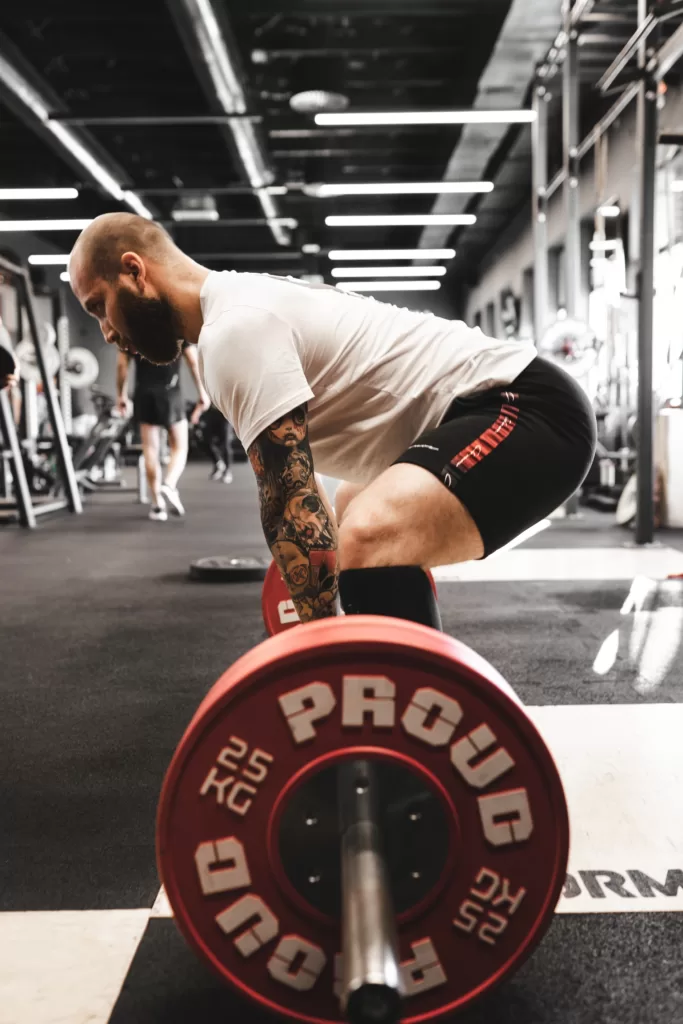
The key to achieving optimal timing lies in understanding the technical nuances of each clean variation and how they affect the execution. In both hang cleans and power cleans, the starting position plays a significant role in setting up the right timing. Whether you start from above the knee (hang position) or from the floor (power position), finding that sweet spot where you can explode with maximum power is essential.
To achieve this explosive power transfer, many lifters use cues such as “exploding through the hips” or “jumping off the ground.” These cues help synchronize your lower body’s extension with your upper body’s pull under the barbell. By mastering this coordination, you’ll be able to generate more power and maximize your lifting potential.
Mistiming can lead to missed lifts or decreased performance
Timing can make or break your clean performance. Mistiming your movements during a hang clean or power clean can result in missed lifts or reduced efficiency. It’s like trying to dance without knowing when to move – you’ll end up stepping on toes instead of gliding across the floor.
In both variations, mistiming occurs when there’s a disconnect between leg drive and pulling under the barbell. If you initiate your pull too early before fully extending your hips and knees, you won’t generate enough upward momentum for a successful lift. On the other hand, if you delay pulling under too long after reaching full extension, gravity will take over and bring down both you and the barbell.
Finding that perfect balance between explosive leg drive and a swift pull under the barbell requires practice and experience. Each lifter’s technique and barbell speed may influence the timing, so it’s crucial to develop consistency through repetition.
Timing varies depending on individual technique and barbell speed
There is no one-size-fits-all approach. The optimal timing for a hang clean or power clean can vary depending on your individual technique and the speed at which you move the barbell.
Some lifters naturally have faster barbell speeds, allowing them to execute their lifts with quicker transitions between phases. These individuals might benefit from slightly different timing cues compared to those who have slower bar speeds. It’s essential to experiment with different timings and find what works best for your unique style.
Technical nuances play a role in determining the ideal timing for each lifter. For example, the starting position of the clean – whether from above the knee (hang position) or from the floor (power position) – can affect how quickly you reach full extension and initiate the pull under.
By paying attention to these details and experimenting with various timings, you can discover what feels most comfortable and efficient for your specific clean variation.
Consistent practice improves timing precision
Timing is not something that magically falls into place overnight; it requires consistent practice over time. Like any skill, mastering proper timing in hang cleans or power cleans takes dedication, focus, and repetition.
To improve your timing precision, incorporate specific drills into your training routine that target this aspect of the lift. For example, practicing clean pulls from various starting positions can help reinforce correct sequencing of movements while developing muscle memory for optimal timing.
Furthermore, video analysis can be an invaluable tool in identifying areas where your timing may be off. Recording yourself performing hang cleans or power cleans allows you to review your lifts objectively and identify any mistimed movements or inconsistencies that need correction.
Remember that perfecting your timing is a continuous process. As you become more familiar with the intricacies of the clean and gain experience, your timing will naturally improve. Stay patient, stay consistent, and keep striving for that perfect synchronization between your legs and upper body.
Decoding the Technique: Mastering Hang Clean Form
Get a Grip
- Start with a grip slightly wider than shoulder-width apart.
- Your hands should be positioned on the barbell with your palms facing down.
- This grip will provide stability and control throughout the movement.
Barbell Placement Matters
- Begin with the barbell at mid-thigh level.
- This starting position allows you to generate power efficiently and effectively.
- It also ensures that you have enough space to fully extend your hips and knees during the lift.
Explode into Action
- Initiate the movement by extending your hips and knees explosively.
- Imagine driving through the ground with force, like you’re trying to jump as high as possible.
- This explosive extension of your lower body is what generates momentum for the hang clean.
Keep it Close
- As you extend your hips and knees, pull the bar upward while keeping it close to your body.
- The bar should brush against your thighs as it travels upward, maintaining a straight path.
Catch it Like a Pro
- Once you’ve pulled the bar upward, it’s time to catch it in a front rack position.
- To do this, quickly drop under the bar by bending at your elbows and rotating your wrists forward.
- As you catch the bar, ensure that your elbows are high and in line with your shoulders.
- This front rack position provides stability for heavier weights and sets you up for success in subsequent movements.
Mastering hang clean form requires attention to detail and practice. Let’s dive deeper into each talking point:
Get a Grip: Having a grip slightly wider than shoulder-width apart gives you better control over the barbell during the hang clean. With palms facing down, this grip creates stability as you progress through each phase of the lift.
Barbell Placement Matters: Starting with the barbell at mid-thigh level allows you to take advantage of the most powerful muscles in your body. By positioning the barbell here, you can generate maximum force during the explosive extension of your hips and knees.
Explode into Action: The key to a successful hang clean is the explosive motion that initiates the lift. Imagine pushing through the ground as hard as you can, like you’re trying to jump as high as possible. This explosive extension generates momentum and sets the stage for a smooth transition into the next phase.
Keep it Close: Throughout the movement, it’s crucial to keep the barbell close to your body. As you extend your hips and knees, focus on brushing the bar against your thighs. This helps maintain a straight path and ensures efficient transfer of power from your lower body to your upper body.
Catch it Like a Pro: As you pull the bar upward, it’s time to catch it in a front rack position. This requires quick reflexes and proper technique. Drop under the bar by bending at your elbows and rotating your wrists forward. As you catch the bar, make sure your elbows are high and aligned with your shoulders. This front rack position provides stability for heavier weights and prepares you for subsequent movements in weightlifting or functional training.
By mastering these techniques, you’ll be well on your way to performing hang cleans with precision and efficiency. Remember to practice regularly, seek guidance from experienced coaches or trainers, and gradually increase weights as you gain confidence in each step of this dynamic exercise.
Decoding the Technique: Mastering Power Clean Form
Grip it and Rip it
- Begin with a grip slightly wider than shoulder-width apart.
- This wider grip allows for better control and stability throughout the movement.
- By placing your hands in this position, you’ll have a solid foundation to generate power from.
From Deadlift to Squat
- Start from a deadlift position, lowering into a squat as you pull.
- The initial setup is similar to that of a deadlift, with the bar resting on the floor in front of you.
- As you begin the lift, push your hips back and lower your body into a squatting position while keeping your back straight.
- This movement helps engage your legs and core muscles, setting the stage for an explosive power clean.
The Triple Extension Explosion
- Generate power by extending hips, knees, and ankles simultaneously.
- Once you’re in the squat position, explode upwards by forcefully extending your hips, knees, and ankles all at once.
- Think of this movement as an explosive jump that propels the barbell off the ground with maximum force.
- By utilizing this triple extension technique, you’ll be able to generate significant power during the power clean.
Catching Lightning in a Front Rack
- Pull your body under the bar quickly to catch it in front rack position.
- As the barbell rises from its initial starting point during the triple extension phase, swiftly pull yourself underneath it.
- Your elbows should drive up and forward while your body drops into a partial squatting position known as the “front rack.”
- This quick transition allows you to catch and stabilize the barbell securely on your shoulders.
Stand Tall with Upright Posture
Maintain an upright posture throughout the movement. During each phase of the power clean – from setup to catch – it’s crucial to maintain proper posture. Keep your chest up, shoulders back, and core engaged to ensure a strong and stable position. By focusing on maintaining an upright posture, you’ll be able to transfer power efficiently and reduce the risk of injury.
Mastering the power clean technique requires attention to detail and consistent practice. By following these key points – starting with a proper grip, transitioning from deadlift to squat, executing a powerful triple extension, catching the barbell in front rack position, and maintaining an upright posture – you’ll be well on your way to mastering this explosive lift.
Remember, practice makes perfect! Don’t hesitate to seek guidance from a qualified coach or trainer who can provide personalized feedback and help you refine your form. With dedication and perseverance, you’ll soon become proficient in the power clean technique and reap its many benefits for strength, power, and overall athletic performance.
Choosing Between Hang Clean and Power Clean: Factors to Consider:
Personal Goals and Training Objectives
When deciding between the hang clean and power clean variations, it’s crucial to consider your personal goals and training objectives. Both exercises offer unique benefits that can contribute to your overall strength, power, and athleticism.
If your primary goal is to improve explosive power and enhance athletic performance, the power clean might be the better choice. This exercise involves lifting the barbell from the floor in one fluid motion, emphasizing speed, triple extension (ankle, knee, hip), and coordination. The power clean targets multiple muscle groups simultaneously, including the hamstrings, glutes, quadriceps, calves, upper back, shoulders, and core.
On the other hand, if you’re focusing on building strength and technique while minimizing lower body stress or fatigue, the hang clean could be more suitable. In this variation of the clean exercise family, you start with the barbell at mid-thigh level or higher instead of from the floor. By eliminating the initial pull from a dead stop position on the ground like in a power clean, you can prioritize refining your technique while still engaging similar muscle groups.
Assessing Mobility, Flexibility, and Strength Levels
Another critical factor to consider when choosing between hang cleans and power cleans is your individual mobility, flexibility levels along with overall strength capabilities.
The hang clean requires less mobility than its counterpart as you don’t have to reach down fully to grab the barbell from a dead stop position on the floor. If you struggle with limited ankle or hip mobility but still want to perform an explosive Olympic lift-like movement without sacrificing form or risking injury due to poor range of motion limitations – then opting for hang cleans may be more suitable for you.
However if you possess good mobility in these areas along with adequate flexibility throughout your body – especially in your hips which are crucial for generating force during a full extension – then power cleans may be an option worth exploring. Power cleans demand a greater range of motion, particularly in the hips and ankles, to execute the exercise correctly.
Strength levels also play a role in determining which variation is more appropriate for you. If you’re still developing your overall strength foundation, it might be beneficial to start with hang cleans as they allow for better technique refinement and gradual progression. As you become stronger and more proficient in the movement patterns, transitioning to power cleans can provide an additional challenge and stimulus.
Evaluating Technical Proficiency in Each Variation
Proper technique is paramount when performing any Olympic lift, including both hang cleans and power cleans. Before deciding which variation to focus on, it’s essential to evaluate your technical proficiency in each movement.
The hang clean allows lifters to break down the full clean into smaller components by starting from an elevated position. This can help beginners or individuals struggling with specific aspects of the lift to isolate and improve their weak points. By practicing from a static position at mid-thigh level or higher, you can concentrate on mastering key elements such as proper bar path, explosive hip extension, shrugging motion, and catching mechanics without worrying about initiating the pull from the floor.
Power cleans require a more comprehensive understanding of the entire movement sequence due to their dynamic nature. From generating force off the ground to smoothly transitioning into triple extension before receiving the barbell on your shoulders or front rack position demands coordination and timing. If you already possess solid technical skills or have experience with Olympic lifting movements like snatches or overhead squats, incorporating power cleans into your routine could be a logical progression.
Determining Specific Muscle Groups Targeted for Development
Understanding which muscle groups are primarily targeted by each variation is crucial when deciding between hang cleans and power cleans based on your specific training goals.
Both exercises heavily involve lower body muscles such as quadriceps, hamstrings, glutes, calves during triple extension and lower body drive. The upper back, shoulders, and grip strength play significant roles in controlling the barbell throughout the movement.
However, power cleans tend to place slightly more emphasis on explosive hip extension and require greater force production from the lower body due to starting from a dead stop position on the floor. This can result in higher recruitment of posterior chain muscles like hamstrings and glutes compared to hang cleans.
Hang cleans, while still engaging these muscle groups, primarily target the mid-thigh level or higher range of motion.
Unlocking Your Weightlifting Potential: Free Program for Snatch and Clean & Jerk
Accessible program for beginners or intermediate lifters
Looking to take your weightlifting game to the next level? Look no further! We’ve got a free program designed specifically for beginners and intermediate lifters who are eager to improve their snatch and clean & jerk techniques. Whether you’re just starting out or have been lifting for a while, this program is accessible to all skill levels.
The focus of this program is on developing your technique, strength, and power in both the snatch and clean & jerk. These two Olympic weightlifting movements are essential for any serious lifter looking to make gains. By following our structured training sessions, you’ll be able to progress steadily towards your goals.
Progressive overload and structured training sessions
One of the key aspects of this program is progressive overload. This means that as you get stronger, we gradually increase the demands placed on your body. By challenging yourself with heavier weights over time, you’ll build both strength and muscle mass.
Our structured training sessions provide a clear roadmap for your weightlifting journey. Each session is carefully planned to target different aspects of the snatch and clean & jerk movements. From working on your pull technique to perfecting your squat position, our program covers it all.
Incorporating hang clean and power clean variations
To ensure well-rounded development in your weightlifting journey, our program incorporates both hang clean and power clean variations within workouts. The hang clean focuses on explosiveness by starting from a “hang” position with the barbell at mid-thigh level. This variation helps improve overall coordination and timing.
On the other hand, the power clean emphasizes pure strength by starting from the floor with an explosive pull that propels the barbell upwards into a racked position on your shoulders. This variation enhances upper body strength while still requiring proper technique throughout.
By including both variations in your training, you’ll be able to target different muscle groups and develop a well-rounded skill set. Plus, it adds variety to your workouts, keeping things interesting and challenging.
Elevating your weightlifting game
With our free program for snatch and clean & jerk, you have the opportunity to elevate your weightlifting game. By following the structured training sessions with progressive overload and incorporating both hang clean and power clean variations, you’ll be well on your way to unlocking your full potential as a lifter.
Remember, consistency is key. Stick with it, push yourself, and watch as you make progress in your technique, strength, and explosiveness. So grab that barbell, get under it with confidence, and let’s lift our way to greatness!
Pros and Cons of Hang Clean vs Power Clean:
Simplicity vs Explosive Power Development
Hang clean offers a simpler starting position compared to power clean. With hang clean, you start with the barbell at your hips or upper thigh level, making it easier to get into position and initiate the movement. This simplicity can be beneficial for beginners or those who may struggle with the technical aspects of the power clean.
However, one drawback of the hang clean is that it may limit overall explosive power development compared to the power clean. In the power clean, you start with the barbell on the floor, requiring you to generate more force from a dead stop. This increased demand for explosive power can lead to greater gains in strength and athleticism over time.
When deciding between hang cleans and power cleans, it’s important to consider your training goals. If your main focus is on building explosive power, then incorporating power cleans into your routine would be advantageous. On the other hand, if you prioritize simplicity and are looking for an exercise that still targets multiple muscle groups while being less technically demanding, hang cleans could be a suitable choice.
Technical Proficiency vs Load Capacity
Power cleans require greater technical proficiency compared to hang cleans. The full range of motion involved in a power clean demands proper technique and coordination between various muscle groups. It requires precise timing and positioning throughout each phase of the lift – from initiating the pull off the floor to catching the barbell in a front squat position.
While mastering this technique may take time and practice, it opens up opportunities for heavier loads during training sessions. The ability to handle more weight in a power clean can lead to greater strength gains as well as improvements in explosiveness.
On the other hand, hang cleans offer a more forgiving learning curve since they eliminate certain aspects of technique required in a full power clean. While this reduced complexity may make them easier to learn initially, it also means that there is a limit to the amount of weight you can handle in a hang clean compared to a power clean.
Ultimately, the decision between hang cleans and power cleans depends on your specific goals and current skill level. If you are willing to invest time in learning and perfecting the technique, power cleans can provide an avenue for increased load capacity. However, if you prefer a simpler movement that still targets multiple muscle groups without requiring as much technical proficiency, hang cleans may be more suitable.
Making an Informed Decision on Hang Clean vs Power Clean
In order to make an informed decision between the hang clean and power clean, it is important to understand the difficulty and complexity of the power clean. The power clean requires a higher level of skill and technique compared to the hang clean. It involves explosive power, coordination, and precise timing.
When exploring the differences between the hang clean and power clean, it becomes evident that they have distinct variations in their execution. The hang clean starts from a static position with the barbell held at mid-thigh level, while the power clean begins from a deadlift position with the barbell on the ground. These variances impact factors such as muscle activation, range of motion, and overall difficulty.
A comprehensive analysis of the muscles worked during the hang clean reveals that it primarily targets muscles in the lower body such as quadriceps, hamstrings, glutes, calves, and hip flexors. It engages muscles in the upper body including traps, deltoids, forearms, and core stabilizers.
Similarly, a comprehensive analysis of the muscles worked during the power clean shows that it also focuses on lower body muscles like quadriceps, hamstrings, glutes, calves, and hip flexors. Furthermore, it activates upper body muscles including traps, deltoids, forearms as well as back muscles like lats and erector spinae.
Timing plays a crucial role in both cleans. It is essential to master proper timing to execute these movements effectively. The ability to coordinate explosive power with precise timing determines successful completion of each lift.
Decoding proper technique for both lifts is vital for maximizing performance gains. Mastering hang clean form involves understanding how to initiate force generation from a static position while maintaining proper posture throughout each phase of movement. On the other hand, mastering power clean form requires proficiency in generating force from a deadlift position while executing swift transitions through various phases.
When choosing between hang clean and power clean, several factors need to be considered. These include individual goals, training experience, physical capabilities, and personal preferences. It is crucial to evaluate these factors in order to make the right decision that aligns with your specific needs and objectives.
To unlock your weightlifting potential and enhance your performance in snatch and clean & jerk exercises, you can take advantage of a free program specifically designed for these lifts. This program can provide guidance on technique, progression, and programming to help you reach new heights in your weightlifting journey.
In conclusion, both the hang clean and power clean have their own pros and cons. The hang clean allows for easier execution while still targeting key muscle groups. On the other hand, the power clean offers a more dynamic movement that requires greater skill but also engages a wider range of muscles. Ultimately, the choice between these two lifts should be based on individual factors such as goals, experience level, and personal preference.
Now it’s time to address some frequently asked questions:
FAQs
Q: Can I perform hang cleans or power cleans without prior weightlifting experience?
A: While it is recommended to have some level of weightlifting experience before attempting hang cleans or power cleans due to their technical nature, beginners can start with lighter weights under proper supervision to learn the correct form gradually.
Q: Which lift is better for building explosive power?
A: Both hang cleans and power cleans are effective for developing explosive power. However, since power cleans involve starting from a deadlift position with heavier weights compared to the hang clean’s mid-thigh starting point, they may offer slightly more potential for building explosive strength.
Q: Are there any alternatives if I don’t have access to barbells?
A: If barbells are not available, variations such as dumbbell cleans or kettlebell swings can be performed to target similar muscle groups involved in the hang clean and power clean. These alternatives can still provide benefits in terms of strength and power development.
Q: How often should I incorporate hang cleans or power cleans into my training routine?
A: The frequency of incorporating hang cleans or power cleans into your training routine depends on factors such as your overall training goals, current fitness level, and recovery capacity. It is recommended to consult with a qualified coach or trainer who can design a program tailored to your specific needs.
Q: Can hang cleans or power cleans help with sports performance?
A: Yes, both hang cleans and power cleans are commonly used in sports-specific training programs to enhance athletic performance. They improve explosive power, coordination, and overall strength, which can translate into improved performance in various sports activities.
Q: Should I prioritize hang cleans or power cleans for muscle hypertrophy?
A: While both lifts can contribute to muscle hypertrophy due to their multi-joint nature and engagement of major muscle groups, exercises targeting specific muscles directly may be more effective for hypertrophy purposes. Hang clean variations primarily focus on lower body muscles while incorporating additional exercises targeting upper body muscles may be beneficial for balanced development.
Q: Are there any safety considerations when performing hang cleans or power cleans?
A: Safety is paramount when performing any weightlifting exercise. It is crucial to start with lighter weights until you have mastered proper form and technique. Ensuring adequate warm-up, using proper equipment (such as weightlifting shoes), and having a spotter or coach present can further enhance safety during these lifts.
Remember that the information provided here is general advice, and it’s always recommended to seek guidance from a qualified professional before starting any new exercise program.

Dave Carter
Dave serves as the head writer and chief content curator for CrossFitopedia.com, the premier destination for CrossFit enthusiasts seeking to enhance their fitness journeys.


